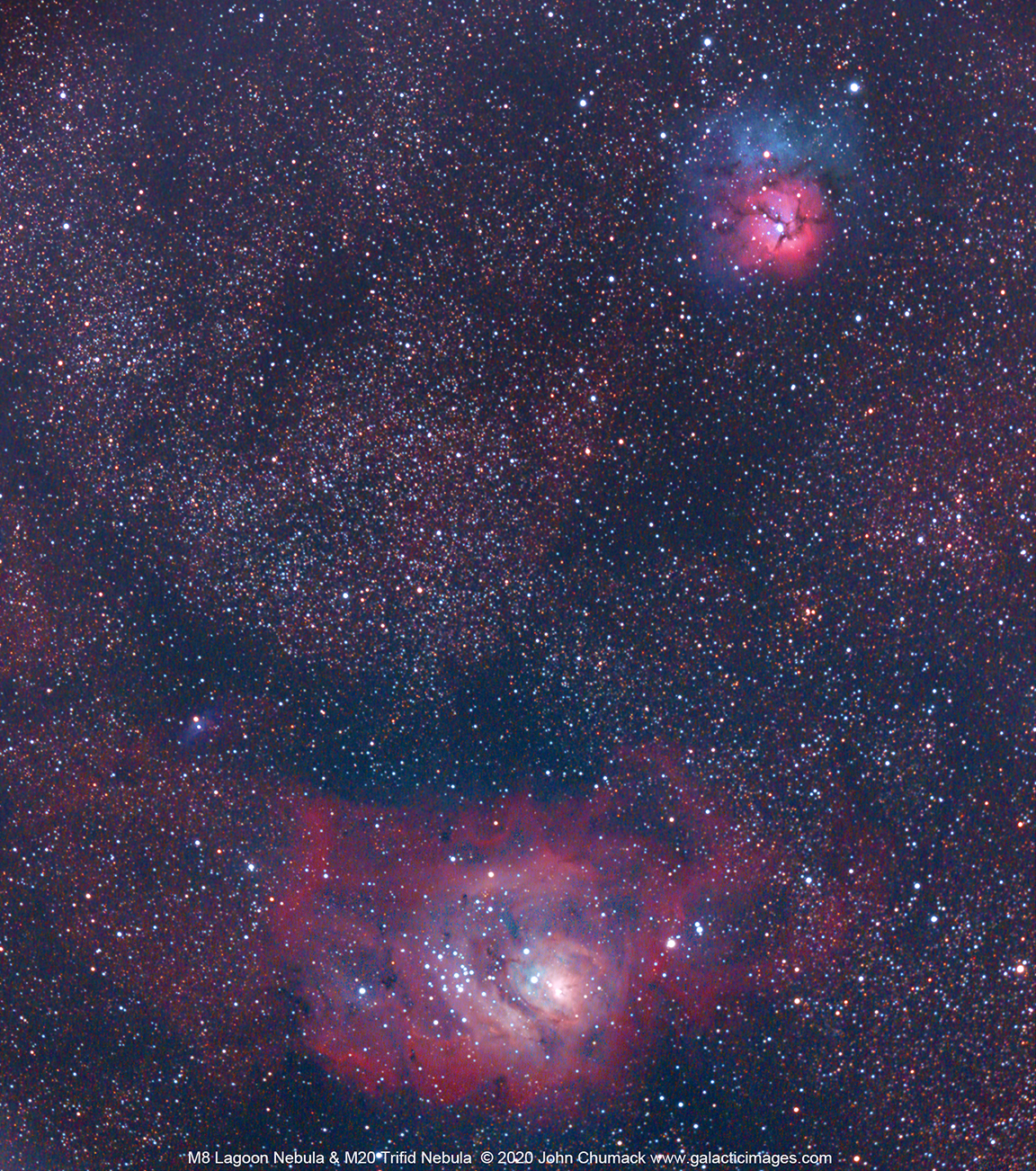M20 The Trifid Nebula(Top) (catalogued as Messier 20 or M20 and as NGC 6514) is an H II region located in Sagittarius.
It was discovered by Charles Messier on June 5, 1764. Its name means ‘divided into three lobes’.
The object is an unusual combination of an open cluster of stars; an emission nebula (the lower, red portion),
a reflection nebula (the upper, blue portion) and a dark nebula (the apparent ‘gaps’ within the emission nebula
that cause the trisected appearance; these dark bands is also designated Barnard 85). This is a very beautiful example of an
Emission & Reflection Nebulae combination.
The bright orange nebulae near the bottom in this image is M8 The Lagoon Nebulae Complex.
Easily visible to the naked eye from a dark location.
Looks great in Binoculars or any small telescope, with the Most apparent or easily visible is the bright star cluster
and nebulae center.
The Lagoon Nebula (catalogued as Messier 8 or M8, NGC 6523, Sharpless 25, RCW 146, and Gum 72) is a giant interstellar cloud
in the constellation Sagittarius. It is classified as an emission nebula and as an H II region.
The Lagoon Nebula was discovered by Giovanni Hodierna before 1654 and is one of only two star-forming nebulae faintly visible
to the eye from mid-northern latitudes. Seen with binoculars, it appears as a distinct oval cloud like patch with a definite core.
Within the nebula is the open cluster NGC 6530.
The Lagoon Nebula is estimated to be about 4,100 light-years away from the Earth. In the sky of Earth, it spans 90′ by 40′,
which translates to an actual dimension of 110 by 50 light years. Like many nebulae, it appears pink in time-exposure color photos
but is gray to the eye peering through binoculars or a telescope, human vision having poor color sensitivity at low light levels.
The nebula contains a number of Bok globules (dark, collapsing clouds of proto-stellar material), the most prominent of which have
been catalogued by E. E. Barnard as B88, B89 and B296. It also includes a funnel-like or tornado-like structure caused by a
hot O-type star that emanates ultraviolet light, heating and ionizing gases on the surface of the nebula. The Lagoon Nebula also
contains at its center a structure known as the Hourglass Nebula.
Although it is a pretty bright nebula, and can be glimpsed near urban areas as a faint fuzzy patch of light,
to really appreciate & enjoy it at its best try to look at it under nice dark skies away from cities or towns!
Want to see more then your eye shows you??? Try binoculars or a small telescope, or even better yet try to photograph it,
as long exposures photos will always show you more then the human eye can see.
This was a quick 32 minute test exposure taken back in on September 20th 2020.
Bisque Paramount ME, & Explore Scientific Carbon Fiber 102mm Triplet APO refractor telescope, Field flattener, and
Stock(unmodified) Canon 6D DSLR, ISO 3200, no auto-guiding, just standard tracking with Sky X pro-track, 16 x 2 minute subs stacked.
Best Regards,
John Chumack
www.galacticimages.com







